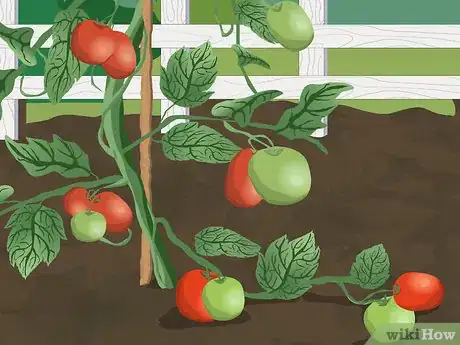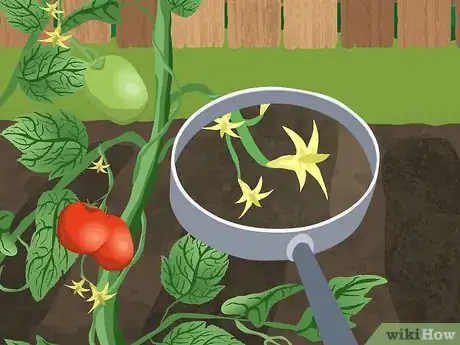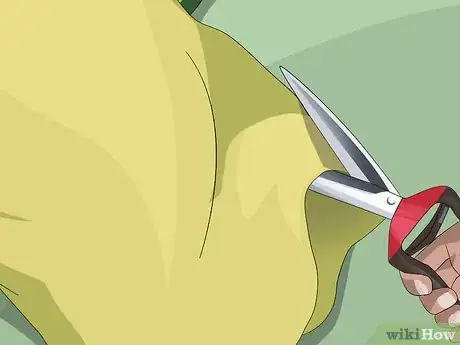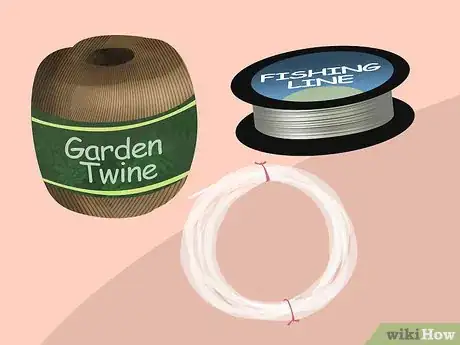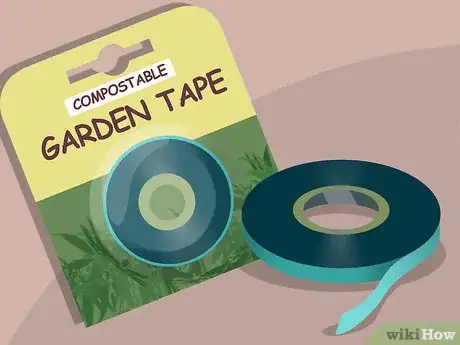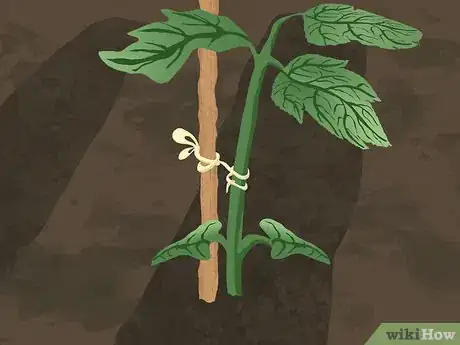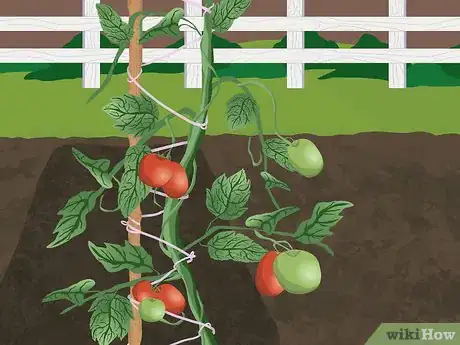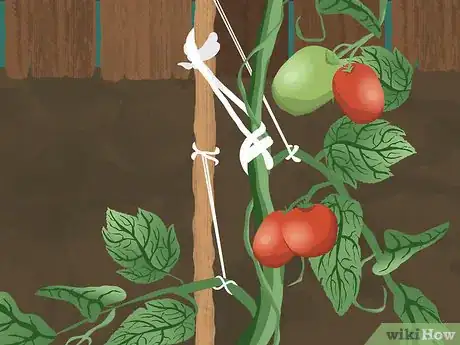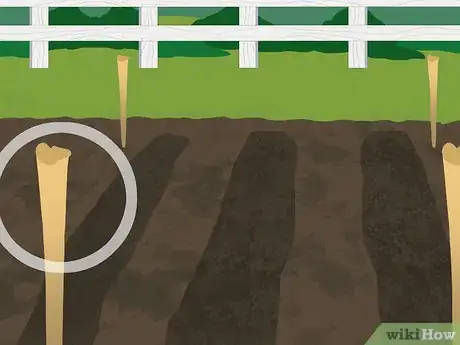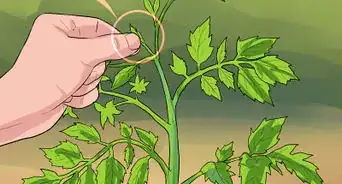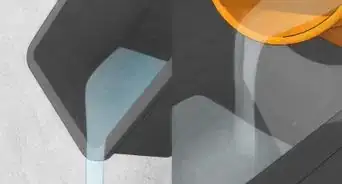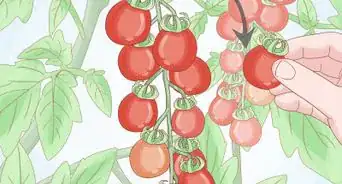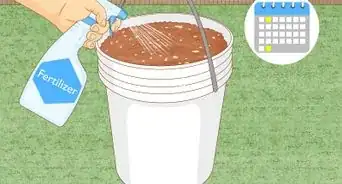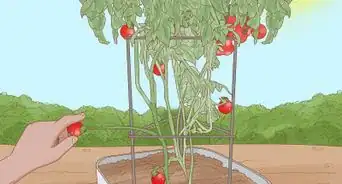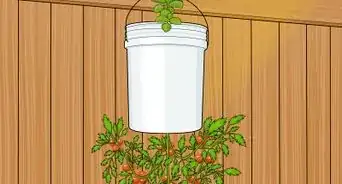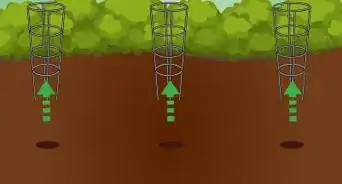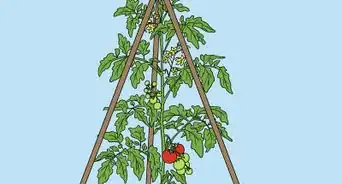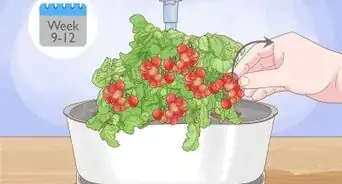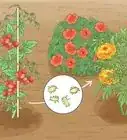This article was co-authored by Andrew Carberry, MPH. Andrew Carberry is a Food Systems Expert and the Senior Program Associate at the Wallace Centere at Winrock International in Little Rock, Arkansas. He has worked in food systems since 2008 and has experience working on farm-to-school projects, food safety programs, and working with local and state coalitions in Arkansas. He is a graduate of the College of William and Mary and holds a Masters degree in public health and nutrition from the University of Tennessee.
There are 7 references cited in this article, which can be found at the bottom of the page.
This article has been viewed 213,668 times.
Tied tomato plants are generally healthier, with tomatoes that are easier to pick. Untied plants will grow along the ground, causing the plants to tangle, the fruits to rot, and make the plant more susceptible to disease. Also, the weight of the fruit can cause branches to break without proper support. Keep in mind, there are thousands of tomato varieties, and the appropriate gardening method may depend on your type of tomato plant.
Steps
Choosing the Right Time
-
1When your tomatoes are 6–10 inches (15.2–25.4 cm) tall tie them up. Its best to do this before the plants begin to droop because they can catch diseases from the soil as soon as any leaves touch the ground.[1]
- Foliage or fruit touching the ground exposes plants to diseases.
- Tomatoes will be cleaner and easier to collect.
-
2Look for new growth. Examine your plants as often as daily. Look for the first appearance of blossoms. Check for branches that are sagging. Also look for branches that are straying too far away from the trellis, stake or cage.[2]Advertisement
-
3Plan to tie branches up throughout the growing season. You'll need to tie both determinate and indeterminate varieties frequently. However, indeterminate tomato plants will need more attention.[3]
- Indeterminate tomato plants make branches and foliage until the first killing frost.
- Determinate tomato plants have a shorter period of production and won't require tying after their primary harvest time.
Selecting a Material
-
1Choose a fabric. Cut or rip old t-shirts or pantyhose. Alternately, use bedsheets or socks. Tear strips of varying lengths.[4]
- Fabric is soft and stretchable, which allows for expansion as your plants grow.
- Fabric needs to be collected and properly disposed of after the growing season. Depending on the material, fabric can take anywhere from a year to decades before it fully decomposes.
-
2Use string or twine. Choose between nylon string or garden twine. Both options are weatherproof, but only certain types of twine are biodegradable.
- Sisal, hemp and cotton twine are compostable as long as they're untreated.
- You'll need to collect nylon at the end of the season. It takes decades to decompose on its own.
- Avoid using fishing line both because it will often cut into your plants and damage them, as well as being a threat to wildlife if you fail to remove it at the end of the growing season.
-
3Use tape. You can purchase Velcro or otherwise self-gripping garden tape. The advantage of garden tape is that you can tie up your whole tomato plant all at once. Unless “compostable” is stated on the package, assume that the tape is not biodegradable.
-
4Try zip ties. Purchase foam or plastic garden ties or zip ties. Zip ties are inexpensive. However, none of these options are compostable and will need to be collected at the end of the growing season. Another disadvantage to ties is that they don't have any expansion capability, so they can cut into the plants if they're applied too tightly, or the plants grow significantly.
- Foam ties provide cushion so that the ties are less likely to cut into the plant.
Applying the Ties
-
1Stake and tie young plants. Drive a stake about a foot into the ground near each plant. Use wood, bamboo or plastic stakes, or make your own stakes with scrap materials. Tie a loose loop around the plant stem, and a knot around the stake.[5]
- Stake and tie plants as soon as you transplant seedlings, or shortly thereafter.
-
2Use a roll to tie up a whole plant at once. Use gardening tape or twine. Secure the end of the roll to one of the lower branches. Starting at the bottom, circle the entire plant with the tape or string. Finish by tying a knot at the top of the support structure.[6]
- This method is useful for plants bigger than three feet.
- As you wrap, place the tape or string at the strongest part of each branch, and wrap it around the cage wire or stake before moving upwards.
-
3Secure the stalk. Tie a string in a double knot around the stake. Find a part of the stalk that is just beneath a branch. Tie a loose double knot around the stalk of the plant.[7]
- Tying a knot beneath a branch prevents downward slippage.
- Do this for every ten to twelve inches of growth.
-
4Tie up individual branches. Find the lower, beefy part of the branch which is below the fork. Wrap your tie around that part of the branch. Tie a double knot. Reach your tie around the tomato's support system, and tie another double knot there.[8]
- Do this gently and carefully. Don't pull the knots or the line very tight.
-
5You might also try the stake and weave method. For a long row of plants, place a stake in the ground between each one and at each end of the rows. Then, tie the garden twine off at the stake at one end and weave it back and forth between the plants and stakes, tying it off tightly to each stake when you get to it. Then repeat weaving the other way.
Community Q&A
-
QuestionIs wire a good material for tying up tomato plants or any kind of climbing vegetable?
 StaubinnCommunity AnswerYou should always use some soft stretchy material, such as old pantyhose. The plant will get damaged by wire, especially in windy conditions. There is also a possibility of burning the stem when the sun is on the plant.
StaubinnCommunity AnswerYou should always use some soft stretchy material, such as old pantyhose. The plant will get damaged by wire, especially in windy conditions. There is also a possibility of burning the stem when the sun is on the plant. -
QuestionWhere do you go to find twine?
 Community AnswerTwine is easily located at most craft stores, some big department stores and hardware stores.
Community AnswerTwine is easily located at most craft stores, some big department stores and hardware stores.
Warnings
References
- ↑ https://bonnieplants.com/library/how-to-support-tomatoes/
- ↑ http://www.tomatodirt.com/tomato-stakes.html
- ↑ http://www.tomatodirt.com/tie-up-tomato-plants.html
- ↑ https://www.hobbyfarms.com/6-garden-hacks-that-reuse-nylon-stockings/
- ↑ https://bonnieplants.com/library/how-to-support-tomatoes/
- ↑ http://www.tomatodirt.com/tie-up-tomato-plants.html
- ↑ https://web.extension.illinois.edu/vegguide/grow_tomato.cfm
- ↑ http://www.tomatodirt.com/tie-up-tomato-plants.html
- ↑ http://www.gardeners.com/how-to/tomato-support-techniques/5378.html
About This Article
To tie up tomatoes, start by driving a stake about 1 foot into the ground next to each plant that’s 6-10 inches tall. Then, use string, garden ties, or strips of fabric to tie a loose loop around the plant stem, and a knot around the stake to keep your plant upright and off the ground. As your plant grows, continue securing the stalk to the stake by tying loose double knots under the branches every 10-12 inches. You should also use gardening tape or twine to tie up the whole plant once it gets to be 3 feet tall. For tips from our Gardening reviewer on how to tie up individual branches throughout the growing season, read on!
